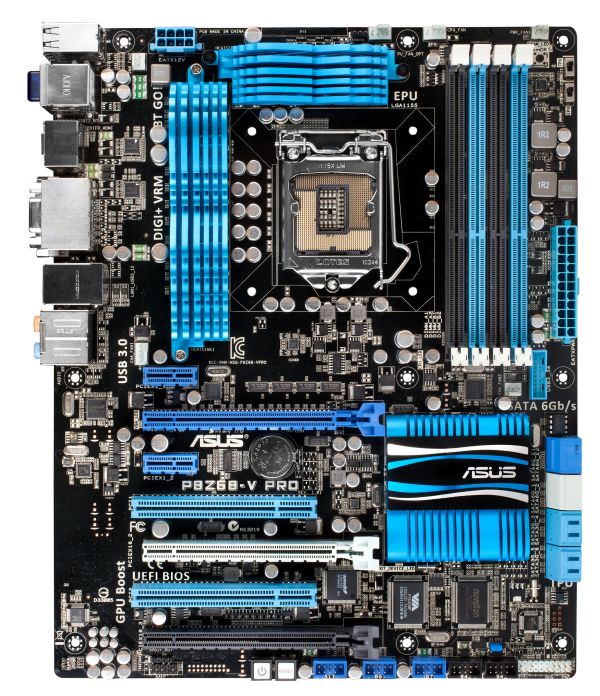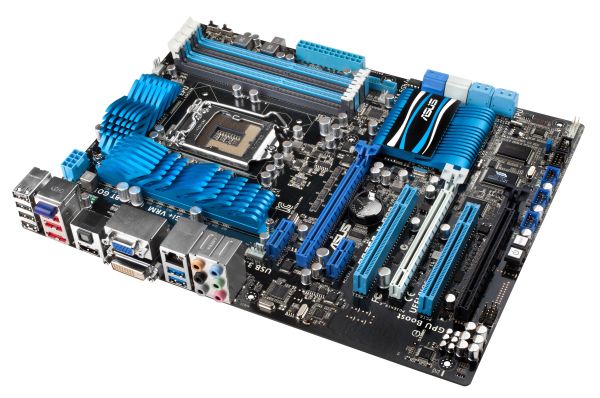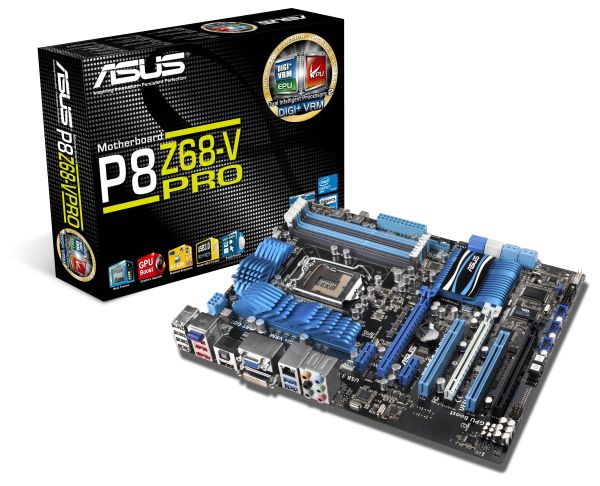ASUS P8Z68-V PRO Review: Our First Z68 Motherboard
by Ian Cutress on May 11, 2011 3:13 AM EST- Posted in
- Motherboards
- Asus
- Z68
ASUS P8Z68-V PRO: Overview
This board from ASUS is a great all-round performer, compared to the P67 boards we have reviewed—space for tri-GPU setups, six fan headers with good OS fan controls, eight SATA ports, six with RAID 0/1/5/10, Intel gigabit Ethernet and it performs well in our benchmark suite. The goods bundled in the box aren't the best we've seen, especially for an expected retail price of $210. But this is a Z68 board—the seemingly logical progression Intel have taken to combine the best bits of P67 and H67, in terms of overclocking. It's thanks to software solutions such as LUCIDLOGIX's Virtu that we can harness both the integrated GPU and discrete GPUs for different work loads—I detail my experiences with Virtu in this review.
ASUS P8Z68-V PRO: Visual Inspection
A quick look at the P8Z67-V PRO board and you might be joining me in thinking it looks almost identical to the P8P67 PRO motherboard. The blue, black and grey livery is still here, with those blue wavy heatsinks covering up the 12 phase CPU and 4 phase iGPU power delivery—unlike other boards, these aren't joined by a heatpipe, and the larger heatsink has a pretty substantial plate connecting the ends on the back of the board.
Around the socket itself, there is one 4-pin chassis fan header near the PCIe 1x, one PWR 3-pin near the 12V CPU power connector, and two CPU fan headers (one 4-pin, one 3-pin) to the top right, which should cover any all-in-one cooling solution with a dual fan and water pump arrangement. Unlike some other Cougar Point motherboards, ASUS have located the PCH to below the DIMM slots, under a large flat heatsink which gets quite warm to touch under normal operation.
Alongside the DIMM slots we have another 3-pin PWR fan header in the top right, just above ASUS' EPU and TPU switches, which activate their Energy Processing Unit and TurboV Processing Units respectively, for lower power usage or automatic overclocking. Enabling both could lead to system instability, however. Underneath these, beyond the 24-pin ATX power connector is a a 3-pin chassis fan header and the USB 3.0 19-pin header. As this is placed here, you would assume ASUS are thinking everyone will be using this header to power a USB 3.0 bracket in the front of the case, rather than the rear. But the supplied USB 3.0 bracket is designed for the rear of the board and doesn't stretch that far, especially over a dual slot GPU should one be in use.
The SATA ports are similar to that found on the P8P67 Pro—the four SATA 3 Gbps from the PCH are in blue, the two SATA 6 Gbps from the PCH are in white, and two SATA 6 Gbps from a Marvell controller. Rather than place the Power/Reset buttons underneath the SATA ports, they are found amongst the myriad of USB and IEEE 1394 headers along the bottom of the board, making them very inconvenient if all three full-size PCIe slots are occupied with dual slot cards.
The PCIe slot arrangement is standard—enough space at the top for a full length PCIe x1 card, with a PCIe x16 slot underneath with a triple slot gap to the next PCIe x16. The three full length PCIe slots run in x16/x0/x4 or x8/x8/x4 mode for GPU setups. However, the bottom PCIe slot shares bandwidth PCIe x1 slots, a two USB ports in the IO panel and the eSATA IO port—all of these are inactive if the bottom PCIe is in x4 mode. By default, the PCIe is in x1 mode, and requires a BIOS setting change for x4.
The IO panel for Z68 boards supporting integrated graphics is a combined mix of previous P67 and H67 iterations, and as such we either lose legacy connections or USB ports infavor of video out ports. There's no PS/2 legacy connector—instead we have on the far left four USB 2.0 ports, then another two USB 2.0 ports, the eSATA 3 Gbps port powered by a JMicron JMB362 controller, and a Bluetooth module. These red USB 2.0 ports/eSATA port are the ones disabled when the third PCIe is in x4 mode. In terms of video outputs, we have a HDMI, DVI and VGA—no display port here, instead you get an optical S/PDIF out (which also means no coaxial S/PDIF out). Just a single gigabit Ethernet port powered by an Intel 82579, and a pair of USB 3.0 ports powered by ASMedia controller. Standard Realtek ALC892 8-channel audio is also present.














95 Comments
View All Comments
Irakusa - Thursday, September 29, 2011 - link
Not really, you're just limiting your thinking a bit. The whole reason I fill datacenters with blade servers and then oversubscribe every resource I can is exactly the same as what NeBlackCat is applying in smaller scale with this line of inquiry.Servers big enough to run hundreds of VMs on demand, but also able to dynamically adjust power, cooling, cost, and wear and tear on components. It's a good thing.
What do you think Intuit does at tax time, build a few thousand new web servers (hoping they have enough) and then leave them sitting around afterward waiting for next year's tax season? No, the reallocate resources where they're needed.
HaryHr - Wednesday, May 11, 2011 - link
Thinking like this you could also say no point in overclocking, just buy Extreme Edition CPU... but that's just not the same.L. - Thursday, May 12, 2011 - link
No.Overclocking = more power for the same mullah
Downclocking = less power for the same mullah
Downclocking = less power/watts
Buying another chip = less mullah, less power, less watts
Basically downclocking is a practice that should disappear shortly as the spectrum of power consumption on available chips has become wide enough, along with low power chips being more than enough for everyone's tasks excluding gaming and extremely rare computational tasks.
shawngmc - Friday, May 13, 2011 - link
Absolutely untrue. I repurpose my hardware - though I buy a new core (CPU/MB/RAM) yearly, I reuse my parts, cycling them through my desktop, HTPC, server, and project PCs or for family members.When I move parts from one usage to another, my demands change. My HTPC should have decent performance but be cool and quiet. My server needs good CPU performance (I run services in VMs) but I prefer energy efficiency there as well. Only my main desktop should be a power-hungry monster.
I'm about to move my i7-930 to my home server. Even with the copious VMs, I probably don't need full clock speed from it. So, since it'll be on 24/7, I want it to be energy efficient. Underclocking? Say, not a bad idea!
NeBlackCat - Wednesday, May 11, 2011 - link
In your opinion. I thought it was supposed to be a general review of the board. This isn't a teenage gamer site - plenty of people are interested in Sandy Bridge/Z68 as a powerful, yet power efficient, platform. And, for many of them, it's useful to know how much you can undervolt while maintaining stock clock, and so on. Some of us like our HTPCs to run as cool and quietly as possible most of the time, for example. It doesn't hurt to cover both sides - a couple of paras covering this is all that's needed.L. - Thursday, May 12, 2011 - link
HTPC Sandy Bridge ?Seriously, if you don't understand hardware and it's use, please just avoid spreading your convictions.
There is no reason for an HTPC to sport anything even remotely as powerful as 1/4th of a Sandy Bridge chip.
We have reached a level in IT equipment where the chip in your mobile phone can almost cater for all of your HTPC / NAS needs so just face it, spend $300 less and get what you need instead of a 99.999999% idle overpowered CPU. Save the planet, green stuff, whatever !
NeBlackCat - Friday, May 13, 2011 - link
Perhaps you don't understand that an HTPC is a 3W Sigma/Realtec media streamer to some, an occasional media encoding powerhouse (as well) to others, and something close to both for an increasing number of people.Vendors increasingly provide idle frugality but performance on tap - in the OS/BIOS, in the chipset (eg. simultaneous clock override/IGP) , in the CPU (eg. turbo boost), in the graphics susbsystem (eg. Virtu, Optimus, etc) and so on.
And these features ARE there in Z68/Sandy Bridge. The question is why they ARE NOT all there in reviews.
PS - that phone able to do HTPC/NAS duties (HD high profile H264, simultaneous transcoding/streaming/recording/multichannel, etc) for $300 less than an entry level Sandy Bridge sounds extremely interesting.
Can you tell me where to by one? Because the tiny TrimSlice Tegra 2 box I've had sitting here for a week (at a cost of $330, which is not $300 short of Sandy Bridge territory) doesn't even get close. Not that I expected it to.
shawngmc - Friday, May 13, 2011 - link
Exactly. I should be able to play games on my HTPC on occasion! Hell, Lucid Vertu theoretically sounds like a great solution - stick a decent GPU in and play modern games - Crysis 2, Portal 2, etc - on my 55" screen? Yes, please.Hell, I'll get some use out of my 3DTV with Nvidia 3DTV Play, now that it's FINALLY available.
xinaes - Wednesday, May 11, 2011 - link
"This segment is made to get the maximum out of your rig and not vice versa."In Soviet Russia, your rig gets the most out of you.
Sorry, couldn't resist.
Glad to see so many other people on the side of not wantonly burning power and still considering the idea of having a reasonably powerful machine.
NeBlackCat - Wednesday, May 11, 2011 - link
I want to get the maximum performance at the maximum power saving out of my rig. ;-)